
SLT as standard for first-line IOP lowering
In an analysis of almost 2,000 eyes treated with selective laser trabeculoplasty as primary therapy for glaucoma, mean IOP decreased 29% and the cumulative probability of success at 10 years was 90%.
TAKE HOME:
In an analysis of almost 2,000 eyes treated with selective laser trabeculoplasty as primary therapy for glaucoma, mean IOP decreased 29% and the cumulative probability of success at 10 years was 90%.
In this video interview, Lawrence F. Jindra, MD, shares his long-term results for SLT when used as a primary, secondary, and replacement therapy. (Video courtesy of Ellex)
New York-Results from a retrospective review of a large series of eyes with long-term follow-up support the use of selective laser trabeculoplasty (SLT) as primary therapy for glaucoma.
The analysis included data from 1,983 eyes identified from a consecutive series of 4,048 eyes treated with SLT over a period of 10 years. Suggested practice guidelines were used from the American Academy of Ophthalmology, the Glaucoma Laser Trial, the Ocular Hypertension Treatment Study, and the Early Management of Glaucoma Trial.
All eyes had a minimum follow-up of 2 months. Average follow-up for the 1,983 eyes was 917 days.
Mean IOP was 18.1 mm Hg prior to SLT, and it decreased to 12.8 mm Hg (–29%) at last follow-up.
Probability of success
Selective laser trabeculoplasty (SLT) is a highly effective approach for first-line glaucoma therapy. It is also effective as adjunct therapy with drugs, and as alternative therapy when drugs or surgery fail. Most importantly, SLT enables ophthalmologists to manage patients' glaucoma treatment without the compliance issues and side effects associated with drug therapy (Figure courtesy of Ellex).
Based on criteria for defining success as decrease in IOP and subsequent maintenance below goal IOP without any need for hypotensive medication, repeat SLT, or filtration/shunt surgery, the cumulative probability of success of SLT as primary therapy was 97% at 1 year, 92% at 5 years, and still 90% at years 7 through 10.
“The Glaucoma Laser Trial established the efficacy of laser trabeculoplasty in lowering IOP in previously untreated patients, while results from the Ocular Hypertension Treatment Study and Early Manifest Glaucoma Trial established the efficacy of early and effective treatment to preserve long-term visual function in [patients with] glaucoma,” said Lawrence F. Jindra, MD, co-author of the study and chief emeritus, Winthrop University Hospital and assistant clinical professor of ophthalmology, Columbia University, New York.
The findings build on these studies in demonstrating SLT produces significant IOP lowering and with durable benefit, he said.
“Further study of SLT in controlled trials is indicated,” Dr. Jindra said. “But given the amount of data and experience on SLT, we believe that prescribing medications instead of SLT for primary treatment of glaucoma today is analogous to performing intracapsular cataract extraction rather than phacoemulsification. It can be done, but why would you?”
Safety of SLT
Dr. Jindra also commented on the safety of SLT, noting that it is not “argon laser trabeculoplasty-lite.”
SLT-performed using a Q-switched, frequency-doubled (532 nm), low-energy Nd:YAG laser-targets melanocytes in the trabecular meshwork. The treatment induces a biologic response that involves release of cytokines that trigger macrophage recruitment and other changes leading to reduction in IOP.
Dr. Jindra
SLT is distinctly different than argon laser trabeculoplasty, and it requires the surgeon to make and accept an intellectual and practical paradigm shift, according to Dr. Jindra.
“SLT has less energy than the average laser used to scan groceries at the checkout,” he said. “So it treats the trabecular meshwork without causing thermal or coagulative damage, without producing peripheral anterior synechiae, but allowing for clinically effective repeatability.”
Lawrence F. Jindra, MD
Dr. Jindra has received honoraria from Ellex Corp. in the past year.
SLT: A new standard in glaucoma treatment
As society continues to become more technologically advanced and patient expectations grow alongside, there is no better time for physicians to rework the antiquated eyedorp-centered glaucoma treatment regime. SLT offers the treatment efficacy and convenience patients today need and stands to give the 1970s-based management of glaucoma a long-awaited shake-up in the 2010, suggests Lawrence F. Jindra, MD. Go to
Newsletter
Don’t miss out—get Ophthalmology Times updates on the latest clinical advancements and expert interviews, straight to your inbox.


















































.png)


